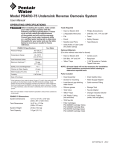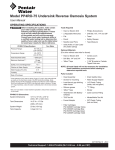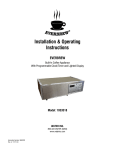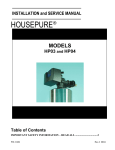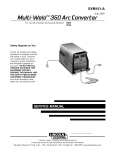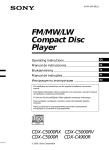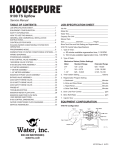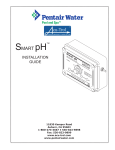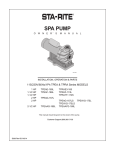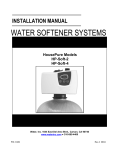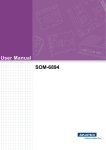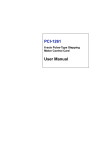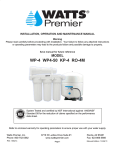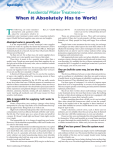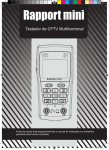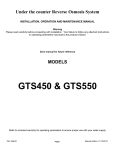Download Model HP-RO-1000 Undersink Reverse Osmosis System
Transcript
Model HP-RO-1000 Undersink Reverse Osmosis System User Manual OPERATING SPECIFICATIONS WARNING: Before installing the system, make certain • Hand or Electric Drill to do so may reduce the effectiveness of the system and will void the warranty. Consult your local water treatment utility • 2 Adjustable Wrenches • Drill Bits: 1/8", 1/4" and 3/8" • File • Towel • Pencil • Safety Glasses the quality for your water and use the table below to record your results for future reference. • Needle-nose Pliers • Tape Measure HP-RO-1000 Specifications Pressure Range: 40–100 psi (2.8–6.9 bar) Temperature Range: 40–100°F (4.4-37.8°C) Total Dissolved Solids < 2000 ppm Maximum Hardness* †: Chlorine in Water Supply: Water Supply pH Limits: Turbidity: Your Water 10 gpg (171 mg/L) † : < 0.1 < 2 ppm 3-11 5 NTU Max. Date of Purchase: * If the hardness of your water is above 10 gpg (171 mg/L), lime scale will build up rapidly on the membrane inside of the RO membrane cartridge. Scale buildup will plug the RO membrane cartridge and make the system ineffective. We do not recommend the HP-RO-1000 to be used with water in excess of 10 gpg (171 mg/L) hardness, unless the water is softened prior to the reverse osmosis system. † Tools Required your water supply complies with the See your local dealer or water treatment specialist to reduce these substances in your water. HP-RO-1000 Dimensions: System Dimensions 13" H x 15" W x 4.75" Dia (330 x 381 x 120.6 mm) Tank Dimensions 14.5" H x 11" Dia (368 x 279 mm) System Weight 23 lbs (10.4 kg) Tank Capacity 3.2 gal (12.1 L) • Phillips Screwdrivers • Utility Knife or Tube Cutter (for plastic tubing) Optional Materials (For sinks without extra hole for faucet) • Hand or Electric Drill • Center punch • Drill Bits: 1/4" and 3/4" • Respirator • • 1-3/8" Bi-metal or Carbide Tipped Hole-saw ® Tape NOTE: All tools listed will not be necessary for installation. Read installation procedures before starting to determine required tools. Parts Included • Head Assembly • Drain Saddle Valve • Screws for mounting • Water Supply Adapter • Lead-free air gap drinking water faucet • Quick-connect Fitting • Silicone grease • Storage Tank • Tank Valve • Faucet Adapter • ® Tape • 3/8" Plastic Tubing (red and blue) • Change Indication Sticker • 1/4" Plastic Tubing (white, red and green) • TDS Test Kit • Filter Cartridges: Filter Kit (to be changed annually) PART # WI-HP-RO-1000-FILTER-KIT Filter Kit Includes: PW-S2500R Cartridge (Yellow) PW-C5000R Cartridge (Blue) PW-C2500R Cartridge (Violet) Membrane (to be changed every 3-5 years) PART # WI-HP-RO-1000-MEMBRANE: PW-RO75R Cartridge (Green) HP-RO-1000-Manual Rev. 2-14 GENERAL PRECAUTIONS WARNING: Do not use with water that is microbiologically unsafe or of unknown quality without adequate disinfection before cyst reduction may be used on disinfected WARNING: The HP-RO-1000 contains a replaceable RO membrane cartridge that is critical to the RO membrane cartridge should be with one and contaminant reduction performance. WARNING: The HP-RO-1000 contains a replaceable RO membrane cartridge, critical for the effective reduction of total dissolved solids. Product water should be tested periodically to verify that the system is working properly. WARNING: The HP-RO-1000 is acceptable for treatment than 27 mg/L nitrate and 3 mg/L nitrite in for nitrate/nitrite reduction only for water supplies with a pressure of 40 psig (280 kPa) or greater. WARNING: The HP-RO-1000 shall only be used for arsenic reduction on chlorinated water supplies containing detectable residual free chlorine at the system inlet. Water systems using an in-line chlorinator should provide a oneminute chlorine contact time before the unit. WARNING: The HP-RO-1000 will not protect against disease-causing bacteria or remove naturallyoccurring harmless bacteria. CAUTION The HP-RO-1000 must be protected against freezing resulting in water leakage. CAUTION Turn off water supply to head without cartridge if it must be left unattended for an extended period of time. CAUTION Do not use electrical heating tape on this unit. NOTE: Substances listed as reduced are not necessarily in your water. System must be maintained according to manufacturer's instructions, including NOTE: Your water must be within required limits for satisfactory operation. If not, the RO membrane cartridge’s life may be shortened and your warranty NOTE: Install on cold water line only. NOTE: Do not install where system will be exposed to direct sunlight. NOTE: Make certain that installation complies with all state and local laws and regulations. included with the system have limited service lives. water indicate that the cartridges and/or membrane should be replaced. NOTE: During extended periods of non-use (such as during a vacation), remove the membrane cartridge them in a sealed plastic bag. Store the cartridges in the refrigerator for future use. When re-starting instructions. 2 • HP-RO-1000 Undersink Reverse Osmosis System NOTE: If the HP-RO-1000 stands for more than 2 to 3 days without being used, the storage tank should be emptied. ® tape without adhesive backing to seal joints. Do not use pipe compound (“pipe dope”), sticks, or similar compounds with this unit; they contain petroleum derivatives which can cause crazing and cracking of the plastic in the NOTE: Use only soap and water to clean components. NOTE: Do not use aerosol sprays (bug spray, cleaning fluids, etc.) near the HP-RO-1000. They contain organic solvents which will cause crazing and cracking of NOTE: After prolonged periods of non-use, such as a vacation, it is recommended that the system be before using. NOTE: Do not use a torch near the unit. HOW REVERSE OSMOSIS (RO) WORKS The HP-RO-1000 uses a semi-permeable membrane to reduce dissolved salts, improving the taste and odor of your water. The RO membrane cartridge contains multiple layers of micron-thin pass through the cartridge, while dissolved salts are rejected. chlorine that may foul the membrane. The RO membrane WATER and REJECT WATER. Your household water pressure forces water through the membrane within the RO membrane cartridge, and into the storage tank. This is product water. Dissolved salts cannot pass through the membrane and are sent to the drain as reject water. When you open the faucet, product water (permeate) is drawn from the storage tank any remaining taste or odor in the water and provides you and your family with cleaner, great-tasting water. The HP-RO-1000 also features an auto shut-off valve, which shuts off the system once the pressure in the storage tank reaches 2/3 of the incoming water pressure (your household water pressure). When you open the faucet to draw water from the storage tank, the pressure inside the tank drops and the auto shut-off valve opens. The system then begins to operate, replenishing the water you took from the storage tank. produced, up to 7 gallons are discharged as reject water. The storage tank can hold up to 3.2 gallons (12.1 L) of water at a time, more than enough for the average family’s drinking and cooking needs. on page 1 of this manual, the RO membrane cartridge of the HP-RO-1000 should last 12–24 months. The precise life span of the HP-RO-1000's RO membrane cartridge will depend on the quality of the water entering the system, and the frequency with which you use it. Frequent use prevents the dissolved salts from building up on the membrane as scale. The more water the system is required to produce, the longer the membrane will last. You may wish to find a variety of uses for your HP-RO-1000 system in order to prolong the life of the membrane. INSTALLATION 2. Selecting the Faucet Location precautions before installing and using your HP-RO-1000 system. NOTE: The HP-RO-1000 may be installed under a sink or in the basement. NOTE: The HP-RO-1000 is installed vertically. NOTE: Numbered diagrams correspond with numbered steps. NOTE: For standard installation on 1/2" 14 NPS threads (most common thread on kitchen faucets) cold water line. 1. Installing the Water Supply Adapter to the cold water supply line. If local codes do not permit the use of the supply adapter, alternate connectors can be obtained from your local retailer. A. Turn off cold water supply line. If cold water line does not have a shut-off valve under the sink, one should be installed. B. Turn on the cold water faucet and allow all water to drain from line. C. Disconnect cold water line from 1/2" 14 NPS threaded stub on bottom of main faucet. D. Screw the water supply adapter to the threaded faucet stub as shown. E. Using the nut that previously connected the cold water line to the faucet, screw the cold water line to the male supply adapter threads. B E C F NOTE: The drinking water faucet should be positioned with function, convenience, and appearance in a 1-3/8" hole. Most sinks have pre-drilled 1-3/8" or 1-1⁄2" diameter holes that may be used for faucet installation. If these pre-drilled holes cannot be used or are in an inconvenient location, it will be necessary to drill a 1-3/8" hole in the sink to accommodate the faucet. WARNING: This procedure may generate dust which can cause severe irritation if inhaled or come in contact with the eyes. The use of safety glasses and respirator for this procedure is recommended. WARNING: Do not attempt to drill through an allporcelain sink. If you have an all-porcelain sink, mount the faucet in pre-drilled sprayer hole or drill through countertop next to sink. WARNING: When drilling through a countertop, make sure the area below the drilled area is free of wiring and piping. Make certain that you have ample room to make the proper connections to the bottom of the faucet. WARNING: Do not drill through a countertop that is more than 1" thick. WARNING: Do not attempt to drill through a tiled, marble, granite or similar countertop. Consult a plumber or the countertop manufacturer for advice or assistance. A. Line bottom of sink with newspaper to prevent metal shavings, parts, or tools from falling down drain. B. Place masking tape over the area to be drilled to help prevent scratches if drill bit slips. C. Mark hole with center punch. Use a 1/4" drill bit for a pilot hole. D. Using a 1-3/8" hole saw, drill a hole completely through D A Figure 1 C D 1 C ⁄4” B 1D1⁄4” A Figure 2 HP-RO-1000 Undersink Reverse Osmosis System • 3 INSTALLATION continued 3. Mounting the Faucet A. Pre-assemble the base. The rubber washer should be in place below the base. The two toggle bolts should be inserted through the base and the rubber washer. The bolts are screwed into the spring-loaded toggle. B. Place the base assembly over the hole in the sink. The two toggles should pass through the hole far enough to spring fully open. If they are not open, unscrew the bolt until the toggle moves down to clear the sink. C. Look down through the base for this step. Before tightening the bolts, determine the correct rotation of the off from the bolt heads. Use Figure 5 to help determine the best position for your installation. Through the hole in the base, hold the toggle in position while tightening the bolt. The spring loaded toggle will contact the bottom of the counter top and hold in position. Do not fully tighten. Repeat for second toggle bolt. Tighten the two bolts evenly. DO NOT OVERTIGHTEN. Tighten only far enough to prevent the base from rotating when the faucet is rotated in place. D. Attach large diameter 3/8" (red) drain tube to the larger long enough to reach the drain clamp in Step 7. E. Locate the 1/4" red brine tube from the right side of the system head assembly. Route the tube through the faucet base and connect to small barb on the faucet. Make certain that the tube is not kinked or stressed once the head assembly is mounted. F. quick connector onto end of threads. G. Wet end of 3/8" blue tube. Push into bottom of connector. Tug gently to be sure connection is complete. This tube should be long enough to reach the top right side of the RO Assembly. H. Check that the O-ring is in place on the faucet. Feed the remaining 3/8" tubes through the base. Hold the B Base O-ring Seat Black Rubber Washer Will Spring Open Figure 4 C Notch For Faucet Blades Must Be Held When Tightening Notch For Faucet 45° Handle Faces This Direction Figure 5 O-ring D left) while pushing down. The faucet will drop into the base. Push down on the faucet and rotate forward (to seated and the faucet held securely in position. I. Insert the spout into the top opening. Hold in position and screw the collar onto the base. NOTE: If the faucet handle is not in the correct position, remove the faucet, loosen the toggle bolts and reposition the base. Tighten the toggle bolts. Then reinstall the faucet. E F G Figure 6 A Base Black Rubber Washer Folds Upward Figure 3 4 • HP-RO-1000 Undersink Reverse Osmosis System INSTALLATION continued 4. Mounting the System CAUTION support the weight of the cartridges and help prevent strain on the water lines. A. Select location under sink or in basement where unit is to be mounted. The head assembly is mounted in a vertical position. B. When mounting the HP-RO-1000 two screws are supplied cabinet 14-1/2". This will provide clearance to change the cartridges. The two screws will be 14" apart and level. Screw the two screws into the wall. Leave a gap between the screw head and the wall of 1/8". The over the screw heads and slide down to lock. 14 Inches Between Holes B 12 Inches From Mounting Hole to Bottom of Cartridge 2-1/2 Inches Clearance Below Cartridges Figure 7 HP-RO-1000 Undersink Reverse Osmosis System • 5 INSTALLATION continued 5. Connecting the Faucet CAUTION Water supply to the tee should have a separate shut-off valve. If it does not, a separate shut-off should be installed. A. Locate the 3/8" blue tubing from the faucet and place a mark 5/8" from the end of the tubing. Moisten the end of the tubing with water and insert into the quick-connect B. Gently pull back on the tubing to ensure it is connected section off of the tubing and reconnect. NOTE: Tubing may be quickly and easily removed from tubing with your other hand. Step 8 A 3/8" Blue Step 5 1/4" Red 3/8" Red Step 9 1/4" White Step 6 Cover Not Shown Yellow Violet Blue Green 1/4" Green Step 11 Figure 8 6 • HP-RO-1000 Undersink Reverse Osmosis System INSTALLATION continued 6. Connecting the Water Supply Adapter A. Determine the length of 1/4" white plastic tubing needed to connect the inlet (white collet) on the left side of the D enough tubing to prevent kinking and cut the tubing squarely. Place a mark 5/8" from the end of the tubing. B. Wet tubing with water and insert into water supply E inserting other end of tubing into inlet of the head assembly. 7. Installing the Drain Clamp NOTE: If you have a single-basin sink with a disposal unit, call Technical support at 1-800-322-9283 for options. NOTE: Before installing the drain clamp, check the drainpipes under the sink for corrosion. Corroded pipes should be replaced before continuing with installation. A. Attach the drain clamp to a vertical section of the drainpipe, about 6" above the trap. Make sure the opening on the drain clamp is facing towards the drinking water faucet. B. a 1/4" hole through one side of the drainpipe. C. Remove the drain clamp from the drainpipe and enlarge edges from the drilled hole. D. Make sure the black rubber gasket is adhered to the inside of the drain clamp and place the drain clamp assembly over the drilled hole. Look through the hole and position the clamp so that the center of the clamp hole is slightly higher (about 1/16") than the center of the drilled hole, see Figure 11. Tighten the clamp securely. E. Screw the plastic compression nut onto the drain clamp until hand-tight. A Figure 11 8. Connecting the Faucet to the Drain NOTE: This is a gravity drain line. Any loops, kinks or sharp bends must be eliminated before proceeding. Failure to create a straight line to the drain may result in reject water leaking through the air gap in the faucet onto the counter top and below the faucet. A. Align the 3/8" red tubing from the faucet with the compression nut on the drain clamp. Create as straight a path as possible with the tubing. Cut the tubing squarely below the nut and remove the internal and external burrs. B. Loosen the compression nut two complete turns. Insert then tighten 1 to 2 turns with a wrench. A B Figure 12 6" Figure 9 B C Figure 10 HP-RO-1000 Undersink Reverse Osmosis System • 7 INSTALLATION continued 9. Installing the Cartridges 11. Putting the System Into Operation CAUTION the model number. Cartridge #1 = PW-S2500R, Yellow Cartridge #2 = PW-C5000R, Blue Cartridge #3 = PW-RO75R, Green Cartridge #4 = PW-C2500R, Violet Install the cartridges in order. If the cartridges are installed A. Slide the cartridge into the head until it stops. B. Twist the cartridge 1/4 turn clockwise until it snaps into place. Gently pull out on the cartridge to ensure the cartridge is locked into place. P W -C 5 0 0 0 R 50 0R 2 3 PW -C 2 -C 2 50 0R on disinfected waters that may contain Milwaukee, WI, US A Assembled in China SH247143 Rev A MR10 PRESSURE RANGE: 30-125° F (2.4-8.6 Bar) For use with PentairWater models: PB4RO-75, PP4RO-75 and PB5RO-75 on disinfected waters that may contain Replace every 12 months TEMPERATURE RANGE: 40-100° F (4.4-37.8° C) For use with PentairWater models: PB4RO-75, PP4RO-75 and PB5RO-75 PW CAPACITY: PRESSURE RANGE: 30-125° F (2.4-8.6 Bar) Warning: Do not use with water that is microbiologically unsafe or of unknown quality without adequate disinfection before or after the systems. Systems CAPACITY: Replace every 12 months TEMPERATURE RANGE: 40-100° F (4.4-37.8° C) 1 Quick Change EP Cartridge © 2010 Pentair Residential Filtration, LLC Milwaukee, WI, US A Assembled in China SH247144 Rev A MR10 P W -S 2 5 0 0 R Quick Change Sediment Cartridge to wall to prevent it from falling and possibly becoming damaged. NOTE: Use caution not to bend or pinch the tubing behind the system while attaching to mounting screws. may make the water appear gray in color. The NOTE: The HP-RO-1000 system does not produce a high does. Water is produced at a slow, drop-by-drop storage tank. As water is taken from the tank, the system automatically starts the cycle of replacing the water and then stops water production when the tank is full. A. Make sure cold water faucet is “off” (Figure 14). B. Make sure tank valve is in the open position. C. Slowly turn on cold water supply. D. for 12 hours, then close it. E. check the installation for leaks. After the storage tank minutes for all of the water to drain from the tank. Close Figure 13 NOTE: Installing the green reverse osmosis cartridge PW-RO75R requires additional force than the other cartridges to rotate into the proper position. Improper installation of the cartridge may prevent water from flowing through the system. To ensure proper installation, rotate the cartridge in the port until the cartridge label faces directly forward and the side tab on the cartridge aligns with the side port on the filter body. 10. Connecting the Storage Tank to the System CAUTION When tank is full, it weighs approximately 35 pounds. Provide ample support under the tank. A. B. Thread the tank valve onto the top of the tank opening by turning it clockwise until snug. C. Locate the green tubing and a mark 3/4" from the end. Moisten one end of the green tubing with water and insert with a twisting motion into the free port of the tank CAUTION Visually check the entire system for leaks. If a leak is present, see TROUBLESHOOTING. F. Repeat Step E four times. NOTE: Initially, the water may appear cloudy. This is a It is not harmful and will disappear in a matter of minutes. It may take up to a week after trapped air to dissipate. The system is ready for operation. You can now enjoy quality water from the HP-RO-1000. Closed Tank Valve B Open Tank Valve NOTE: Do not cut green tube. This line should be left at the pre-cut length for future service. NOTE: The pressurized storage tank has capacity of 3.2 gallons. The tank's air pressure is factory set at 5 to 7 psi when tank is empty. Figure 14 8 • HP-RO-1000 Undersink Reverse Osmosis System A OPTIONAL INSTALLATION CONNECTING THE HP-RO-1000 TO REFRIGERATOR ICEMAKER/WATER DISPENSER CAUTION If you are connecting the HP-RO-1000 to your refrigerator/icemaker with initial system installation, wait to turn on the icemaker until the Post- Filter Cartridge (on the right side of the Step 11. CAUTION NOTE: For optimum performance, it is recommended that the distance between the HP-RO-1000 and the refrigerator icemaker/water dispenser be no greater than 10 feet (3 m). At distances greater than 10 feet, the water pressure from the system may not be adequate to deliver water to the refrigerator. Materials Required (available from Water, Inc.) • 3/8" x 3/8" x 3/8" (9.5 x 9.5 x 9.5 mm) compression or quick-connect tee. • 3/8" (9.5 mm) polyethylene tubing (maximum length of 10 feet [3 m] recommended) • Shut-off valve A. Turn off icemaker and refrigerator water supply. Consult manufacturer’s guidelines. B. Close tank valve (on top of storage tank). C. Turn off water to the system at the cold water supply. D. Open drinking water faucet to relieve pressure. E. Locate blue tubing leading to your drinking water faucet. Cut and insert the 3/8" x 3/8" x 3/8" (9.5 x 9.5 x 9.5 mm) compression or quick-connect tee into the blue tubing (Figure 15). Consult manufacturer’s guidelines before installing the tee connection. NOTE: When cutting the blue tubing, you may experience some water leakage. F. Using a length of 3/8" polyethylene tubing, connect the icemaker/dispenser line with the free port on the compression tee. G. The shut-off valve should be installed as close to this port of the tee as possible. Shut-off valve should be installed in the OFF position. Consult manufacturer’s guidelines before installing the shut-off valve. H. Completely open cold water supply (until it comes to a stop). I. Open tank valve. J. Turn off the drinking water faucet. K. Open shut-off valve at the tee connection. L. Turn on ice maker. Consult manufacturer’s instructions. M. Check for leaks and tighten connections if necessary. Tubing to drinking water faucet Tubing to refrigerator Tubing from system outlet Figure 15 HP-RO-1000 Undersink Reverse Osmosis System • 9 TESTING YOUR REVERSE OSMOSIS SYSTEM Total Dissolved Solids (TDS) Test NOTE: Under NSF/ANSI Standard 58, it is highly recommended that you (the consumer) have your water tested at least every 6 months to verify that your system is performing satisfactorily. Sampling Instructions: Sampling instructions are included with the Total Dissolved Solids (TDS) Test Kit. If the TDS Test Kit is missing from your unit, please call Customer Support at 1-800-322-9283 for a replacement. CHANGING THE CARTRIDGES Materials Needed • Replacement Cartridges (color coded): PW-S2500R Cartridge Yellow PW-C5000R Cartridge Blue PW-RO75R Cartridge Green PW-C2500R Cartridge Violet when the water pressure at the faucet begins to drop time. The cartridges are color coded to indicate which location they are installed into. 1. Changing the Cartridges Total Dissolved Solids Test Kit Figure 16 WHEN TO CHANGE THE CARTRIDGES The life of the cartridge depends on the water volume used and the substances in the water. Normally, cartridges should be changed at intervals of 6 months. Replace the cartridge sooner if the water pressure at the faucet begins to drop noticeably or water. NOTE: Only the replacement cartridges listed can be used with this system. Failure to use recommended replacement cartridges will void your warranty. A. Place a small pan or towel under the HP-RO-1000 to catch any water that may drip. B. housing) counter-clockwise for a 1/4 of a turn, and pull the cartridge out of the system. If the system has any C. Push the new cartridge into the head until it can go no further. D. Twist the cartridge 1/4 turn clockwise until it snaps into place. E. Gently pull the cartridge straight out to ensure the cartridge is locked into place. F. Repeat for all other cartridges. G. Turn on water and check for leaks. If leaks are found, see Troubleshooting. H. 2. Flushing the RO membrane NOTE: The HP-RO-1000 system does not produce a high does. Water is produced at a slow, drop-by-drop storage tank. As water is taken from the tank, the system automatically starts the cycle of replacing the water and then stops water production when the tank is full. A. Make sure cold water faucet is “off” (Figure 14). B. Make sure tank valve is in the open position. C. Slowly turn on cold water supply. D. for 12 hours, then close it. E. check the installation for leaks. After the storage tank minutes for all of the water to drain from the tank. Close CAUTION Visually check the entire system for leaks. If a leak is present, see TROUBLESHOOTING. F. Repeat Step E four times. 10 • HP-RO-1000 Undersink Reverse Osmosis System TROUBLESHOOTING Leaks on Supply Adapter Connection 1. Turn off water supply valve and turn on drinking water faucet to release pressure in system. 2. out leaking tubing by pressing collar surrounding tubing while pulling the tubing with your other hand. 3. Inspect to see if plastic tubing is scratched and supply adapter was properly attached. 4. If tubing is scratched, cut off 1/2" to 5/8" and reinstall. Leaks on Faucet/Tubing Connection 1. Turn off water supply valve and turn on drinking water faucet to release pressure. 2. Unscrew tubing nut at bottom of faucet. Inspect the tubing. The insert, plastic ring and tubing should not be damaged. 3. Check if insert is in place and tubing is cut squarely and not scratched, cut tubing if necessary to get square smooth end. 4. If the tubing is smooth and square, reconnect tubing by inserting into faucet and tightening nut. The plastic ring should be held tight to the faucet system when the nut is tight. 5. Turn on water supply valve, then close faucet and check for leaks. NOTE: If leaks persist, or if there are other leaks on system, turn off water supply and call Technical Support 1-800-322-9283. Leaks Between Cartridge and Filter Housing 1. Turn off cold water supply to system at saddle valve. Close tank valve. Open drinking water faucet to relieve water pressure. 2. Remove the cartridge, inspecting it for damage. Inspect O-rings to make sure they are seated and clean. 3. 4. Turn on water supply at saddle valve. Open tank valve. Leaks at Quick-Connect Fittings CAUTION The 1/4" red tubing connected to the top of the The system will not operate correctly if the restrictor is removed. 1. Close tank valve, close saddle valve, and open drinking water faucet. 2. the tubing with your other hand. 3. Cut off 1" of tubing. Tubing should be cut squarely. Internal and external burs should be removed. Place a mark on tubing 5/8" from end on 1/4" tubing or 3/4" from end on 3/8" tubing. 4. 5. Open the saddle valve until it comes to a stop. Open the tank valve and close drinking water faucet. If leaks persist, call Technical Support. Leaks from Faucet 1. Check to make sure white tubing leading from the drinking water faucet to the drain is as straight as possible (it is usually necessary to cut this line during installation). Any to the drain. 2. Check to make sure the drain clamp and the drain hole are properly aligned, refer to Figure 7 on page 7). 1. Check to make sure there is no foreign matter clogging the drain line or at the drain clamp hole. If leaks persist, call Technical Support. No Flow or Slow Flow from the Brine (Reject) Line (Less the unit is producing water by turning the valve on the storage tank off and opening the drinking water faucet. Water should drip from faucet. 1. leaks persist, call Technical Support. Leak Between Tank Valve and Storage Tank 1. Turn off water supply to system at the saddle valve. Open faucet to drain storage tank. Let faucet run for 3–5 minutes until it drips. 2. Remove green tubing from tank valve by pressing the collar hand. 3. Unscrew the tank valve from the storage tank. ® tape on the threads of the 4. storage tank. 5. Thread the tank valve onto the top of the tank opening by turning it clockwise until snug. 6. Cut off 1" of tubing. Tubing should be cut squarely. Internal and external burrs should be removed. Place a mark on tubing 3/4" from end of tubing. 7. 2. High TDS in Product Water 1. If high TDS (Total Dissolved Solids) is detected in the product water, the RO Cartridge may need to be replaced new installation, call Technical Support. 2. Otherwise, draw 1 gallon of water from the unit. After 10 minutes, then run water from the faucet and test the water again. 3. Determine when you last changed the RO Filter Cartridge and call Technical Support. 8. Turn water supply on at the saddle valve and close drinking water faucet. 9. Allow system to pressurize for several hours and check for leaks. 10. Check for leaks after tank is fully pressurized (1–3 hours). If leak persists, call Technical Support . HP-RO-1000 Undersink Reverse Osmosis System • 11 TROUBLESHOOTING continued Limited Flow at Drinking Water Faucet 1. Turn off water supply to system at saddle valve. 2. 3. Unscrew the blue cap at the base of the storage tank to expose air valve. Use a small air compressor or bicycle pump to add air to the storage tank. This will force the water out of the storage tank through the faucet. Continue to add air until no more water comes out of the faucet. 4. Turn off the drinking water faucet. 5. Using an air pressure gauge, adjust the pressure in the storage tank to 5–7 psi. 6. Replace the blue cap. 7. Open the saddle valve until it comes to a stop. Let the approximately 33 pounds. If performance has not improved, call Technical Support. Sudden Return of Taste and Odor If shortly after complete servicing, noticeable taste and odors return, contact Technical Support. If you are experiencing a problem not listed in this manual, shut off the water supply at the saddle valve and close the tank valve. Call Technical Support at 800-322-9283. 12 • HP-RO-1000 Undersink Reverse Osmosis System WARNING: Do not use with water that is microbiologically unsafe or of unknown quality without adequate disinfection before cyst reduction may be used on disinfected REPLACEMENT PARTS For replacement parts contact your local retailer or call Customer Service at 1-800-322-9283. Item # NOTE: Substances that may be reduced are not necessarily in your water. Filter must be maintained according to manufacturer’s instructions, including Part Number 244877 Storage Tank 3.2 Gal 1 2 555612-96 Cartridge, Sediment PW-S2500R, Yellow 1 3 555586-96 Cartridge, Carbon Block PW-C5000R, Blue 1 4 555676-96 Cartridge, RO Element, 75 GPD PW-RO75R, Green 1 5 555585-96 Cartridge, GAC PW-C2500R, Violet 1 6 244876 REPLACEMENT CARTRIDGES: Filter Kit (to be changed annually) PART # WI-HP-RO-1000-FILTER-KIT Filter Kit Includes: PW-S2500R Cartridge (Yellow) PW-C5000R Cartridge (Blue) PW-C2500R Cartridge (Violet) Membrane (to be changed every 3-5 years) PART # WI-HP-RO-1000-MEMBRANE: PW-RO75R Cartridge (Green) QTY 1 MAINTENANCE For replacement cartridges, you can: • go to waterinc.com • find a local dealer at dealer.waterinc.com • or call 800-322-9283 Description Kit, Faucet 1 244857 Faucet, Air Gap - Paragon (includes Toggles) 1 244783 Valve, RO Tank 1/4" NPT x 1/4" QC 1 247117 Label, Water Change Reminder 2 1-459-00 Mounting Screw 2 143495 Lubricant, Silicone Packet 1 244796 Drain Clamp, 3/8" QC 1 244797 Inlet Adaptor, 1/2" FIPS x 1/2" MIPS x 1/4" QC 1 244880 Faucet Adaptor, 1/4" NPT x 3/8" QC 1 150646 TDS Test Kit 1 7 244849 Tube, 3/8" OD Red - Faucet Drain 1 8 244848 Tube, 3/8" OD Blue - Permeate 1 9 244794 Tube, 1/4" OD White PE 1 10 244850 Tube, 1/4" OD Green 1 11 244875 Tube, 1/4" OD Red 1 12 357484 Head Assembly Includes Bracket, Screws, Manifold Assembly and Plastic Tee 1 HP-RO-1000 Manualt (Not Shown) 1 HP-RO-1000-Manual Rev. 2-14 1 12 6 IT’S TIME TO CHANGE YOUR Place this half IT’S of theTIME label on TOyour CHANGE YOUR calendar, date book or refrigerator. Place this half of the label on your calendar, date book or refrigerator. Bend and Peel Here month day SILICO NE LUBRIC ANT Bend and Peel Here cartridge on: 2 year cartridge on: 3 4 5 For more info:1-800-279-9404 SH247117 JA10 month day year For more info:1-800-279-9404 SH247117 JA10 7 8 9 10 11 HP-RO-1000 Undersink Reverse Osmosis System • 13 Arsenic Fact Sheet Arsenic (abbreviated As) is found naturally in some well water. Arsenic in water has no color, taste or odor. It must be measured by a lab test. Public water utilities must have their water tested for arsenic. You can get the results from your water utility. If you have your own well, you can have the water tested. The local health department or state labs. The cost is typically $15 to $30. Information about arsenic in water can be found on the Internet at the US Environmental Protection Agency web site: www.epa.gov/ safewater/arsenic.html. There are two forms of arsenic: pentavalent arsenic [also called As(V), As(+5), and arsenate] and trivalent arsenic [also called As(III), As(+3) and arsenite]. In well water, arsenic may be pentavalent, trivalent, or a combination of both. Special sampling procedures are needed for a lab to determine what type and how much of each type of arsenic is in the water. Check with the labs in your area to see if they can provide this type of service. Reverse osmosis (RO) water treatment systems do not remove trivalent arsenic from water very well. RO systems are very effective at removing pentavalent arsenic. A free chlorine residual will rapidly convert trivalent arsenic to pentavalent arsenic. Other water treatment chemicals such as ozone and potassium permanganate will also change trivalent arsenic to pentavalent arsenic. A combined chlorine residual (also called chloramine) may not convert all the trivalent arsenic. If you get your water free chlorine or combined chlorine is used in the water system. The HP-RO-1000 system is designed to remove pentavalent arsenic. It will not convert trivalent arsenic to pentavalent arsenic. The system was tested in a lab. Under those conditions, the system reduced 0.30 mg/L (ppm) pentavalent arsenic to 0.010 mg/L (ppm) (the USEPA standard for drinking water) or less. The performance of the system may be different at your installation. Have the treated water tested for arsenic to check if the system is working properly. The RO component of the HP-RO-1000 system must be replaced every 12-24 months to ensure the system will continue to remove pentavalent arsenic. The component component are listed in the installation/operation manual. 14 • HP-RO-1000 Undersink Reverse Osmosis System HousePure HP-RO-1000 Performance Data Important Notice: Read this performance data and compare the capabilities of this system with your actual water treatment needs. It is recommended that before installing a water treatment system, you have your water supply tested to determine your actual water treatment needs. This system has been tested according to NSF/ANSI 58 for the reduction of the substances listed below. The concentration for the indicated substances in water entering the system was reduced to a concentration less than or equal to the NSF/ANSI 58. NOTE: Substances that may be reduced are not necessarily in your water. Filter must be maintained according to manufacturer’s instructions, including to the system that is available to the user as reverse osmosis treated water under operating conditions that approximate typical daily usage. The tested recovery rating is 27.40%. Substance Standard 58 Arsenic V Barium Cadmium Chromium III Chromium VI Copper Cysts Fluoride Lead Radium 226/228 Selenium Total Dissolved Solids Turbidity Standard 42 Chlorine Concentration Maximum Permissible Product Water Concentration Reduction Requirements Average Reduction 0.050 mg/L ± 10% 10.0 mg/L ± 10% 0.03 mg/L ± 10% 0.3 mg/L ± 10% 0.3 mg/L ± 10% 3.0 mg/L ± 10% Minimum 50,000/mL 8.0 mg/L ± 10% 0.15 mg/L ± 10% 0.010 mg/L 2.0 mg/L 0.005 mg/L 0.1 mg/L 0.1 mg/L 1.3 mg/L 27pCi/L ± 10% 5pCi/L 80% 1.5 mg/L 0.010 mg/L 99.95% 97.6% 96.7% 98.2% 97.6% 97.0% 98.8% 99.99% 96.2% 99.0% 0.10 mg/L ± 10% 0.05 mg/L 98.0% 750 mg/L ± 40 mg/L 187 mg/L 94.9% 11 mg/L ± 1 NTU 0.5 NTU 99.1% 2 mg/L >=50% 93.0% Production Rate: 24.83 gpd to the membrane portion of the system that is available to the user as reverse osmosis treated water when the system is operated without a storage tank or when the storage tank is bypassed. The HP-RO-1000 is Tested and Certified by NSF International against NSF/ANSI Standard 42 and 58 for the reduction of substances listed in the table above. Testing was performed under standard laboratory conditions, actual performance may vary. State of California Department of Public Health Water Treatment Device Certicate Number 11 - 2097 Date Issued: October 24, 2011 Trademark/Model Designation HousePure HP-RO-1000 Replacement Elements PW-RO75R (RO Membrane) PW-S2500R (Pre Filters) PW-C5000R (Pre Filters) PW-C2500R (Post Filter) Manufacturer: Pentair Residential Filtration, LLC The water treatment device(s) listed on this certificate have met the testing requirements pursuant to Section 116830 of the Health and Safety Code for the following health related contaminants: Microbiological Contaminants and Turbidity Cysts Turbidity Organic Contaminants None Rated Service Capacity: 1250 gal service cycle Inorganic/Radiological Contaminants Arsenic (pentavalent)1 Barium Cadmium Chromium (hexalent) Chromium (trivalent) Copper Fluoride Lead Radium 226/228 Selenium Rated Service Flow: 24.8 gpd Conditions of Certification: Do not use where water is microbiologically unsafe or with water of unknown quality, except that systems certied for cyst reduction may be used on disinfected waters that may contain lterable cysts. 1 Claims for arsenic reduction shall only be made on water supplies maintaining detectable residual free chlorine at the reverse osmosis (RO) system inlet. Water systems using an in-line chlorinator should provide a minimum of 1 minute chlorine contact time before the RO system. HP-RO-1000 Undersink Reverse Osmosis System • 15 HP-RO-1000 Water, Inc. LIMITED WARRANTY Water, Inc. warrants to the original owner (under normal use): Reverse Osmosis System to be free from defects in material and/or workmanship one (1) year from the date of purchase. Any replacement products furnished will be free from defects in material and/or workmanship for the remainder of the original warranty period. This warranty does not cover: (1) pre and post filter cartridges, or reverse osmosis membrane (2) defects not reported within the above time period, (3) items manufactured by other companies, (4) problems arising from failure to comply with Water, Inc. instructions, (5) problems and/or damage arising from acts of nature, abuse, misuse, negligence or accident by any party other than Water, Inc., (6) problems and/or damage resulting in whole or in part from alteration, modification, repair or attempted alteration, modification or repair by any party other than Water, Inc., (7) noncompliance with applicable codes/ordinances. If a defect in workmanship and/or material in a product or part covered by the warranty should arise, Water, Inc., at its sole discretion, will repair or replace the defective product or part (Water, Inc. may consider, in good faith, the customer’s preference). All claimed defective product must: (1) be authorized for return by Water, Inc. with an RGA number (2) include proof of the purchase date of the product or part (3) returned to Water, Inc. prior to the expiration of the warranty date, at the customer’s expense, shipment pre-paid, (4) be accompanied by a letter detailing the Model Number, Serial Number (if any), and a brief description of the problem. TO THE MAXIMUM EXTENT PERMITTED BY APPLICABLE LAW, WATER, INC. DISCLAIMS ALL OTHER WARRANTIES, WHETHER EXPRESS OR IMPLIED, INCLUDING, BUT NOT LIMITED TO, THE IMPLIED WARRANTY OF MERCHANTABILITY AND FITNESS FOR A PARTICULAR PURPOSE, WITH REGARD TO THE PRODUCTS, PARTS AND ANY ACCOMPANYING WRITTEN MATERIALS. To the maximum extent permitted by applicable law, Water, Inc. shall not be liable for any damages whatsoever (including, but not limited to, loss of time, inconvenience, expenses, labor or material charges incurred in connection with the removal or replacement of the system, special, incidental, consequential, or indirect damages for personal injury, loss of business profits, business interruption, loss of business information, or any other pecuniary loss) arising out of the use of or inability to use the defective products or parts, even if Water, Inc. has been advised of the possibility of such damages. Water, Inc. maximum liability under any provision of this Limited Warranty shall be limited to the amount actually paid for the system. NOTE: Because some states do not allow the exclusion or limitation of incidental or consequential damages, the above limitations or exclusions may not.apply THIS WARRANTY GRANTS SPECIFIC LEGAL RIGHTS, AND OTHER RIGHTS MAY APPLY. SUCH RIGHTS VARY FROM STATE TO STATE. Buyer Seller Date Water Inc 1044 E. Del Amo Blvd. Carson, CA 90746 800.322.WATER(9283) waterinc.com ©2014 Water, Inc. HP-RO-1000-Manual Rev. 2-14
















